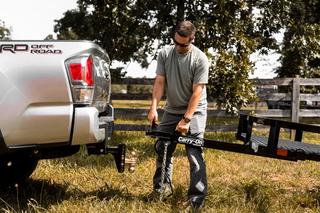Tips for Hauling Your Trailer
Hitching Yourself to Safety


Whether it’s a new purchase or a tried-and-true workhorse, knowing how to properly load, connect and tow a trailer can make a big difference in your workflow. It can also save you time, protect your equipment and keep you safe on the road.
Before heading out to pick up your building materials, mulch or heavy equipment, these towing tips and best practices will help you get the job done.
Understanding Your Limits
When planning to haul something, make sure you know your trailer’s gross vehicle weight rating (GVWR) to determine what weight you can handle (the combination of both your trailer and the cargo you wish to tow). Look for the GVWR on the VIN label of your trailer.
Next, check your vehicle's towing capacity. This is the maximum weight it can safely tow, including the weight of the trailer and its cargo. Understanding the trailer's GVWR and the towing capacity of your pulling vehicle helps ensure you maintain safe towing practices.
Securing Your Connection
When getting ready to tow your trailer across your property or across town, there are steps you need to take to ensure a safe trip. One of the most important is knowing how to properly hitch and secure your trailer to your tow vehicle.
To hitch a trailer safely, first align your tow vehicle and trailer, then slowly begin to back up so the hitch ball is near or aligned with the coupler. Secondly, lower the trailer’s tongue until the coupler fully engages with the hitch ball. If the coupler and hitch ball won’t line up, adjust your tow vehicle’s position.
Next, secure the latch and engage the coupler locking mechanism. When engaged, this will securely hold the coupler to the hitch ball. Then, insert a safety lock pin through the hole in the locking mechanism.
Next, attach the safety chains in a crisscross pattern under the hitch to prevent the trailer from detaching. Connect the electrical plug to ensure brake lights and turn signals work. Finally, raise the trailer jack, ensuring the trailer is level. Double check all connections before driving.
These steps will help you hitch and secure your trailer correctly and safely for smooth towing.
Clearing Up Confusion on Safety Chains
While they may seem like a small detail, safety chains are essential for securing your trailer to your vehicle. Attached from the trailer tongue to the tow vehicle, they act as a backup connection, ensuring that if the primary hitch (ball or coupler) fails, the trailer remains attached to the vehicle.
Properly crossed and fastened safety chains help control the trailer's movement, keeping it aligned with the tow vehicle. They are a crucial safety feature, mandated by law in many areas, and they enhance your overall towing security.
For peace of mind and compliance, always use safety chains when towing a trailer.
Using Proper Loading Techniques
Some may be surprised to learn there actually is a right way to load your trailer. Although the type of cargo may vary, your trailer should be loaded heavier in the front of the deck — this should be about 60% of your cargo weight.
Remember to pack your cargo closely and firmly, using tie-downs or other tensioning devices to keep cargo secure. Small items should be loaded at the height of the sides of the trailer, even if you are only transporting something a short distance away.
As always, consult with your owner’s manual or dealer for the most specific loading and towing instructions for your trailer type. By following safe connecting, loading and towing practices, you can reduce some stress while ensuring a more productive workday. Plus, you’ll also reap the benefits of safeguarding your vehicle and equipment for years to come.
Towing Safety Best Practices
Once your trailer has been properly loaded, there are some general precautions for towing safety to keep in mind. These apply no matter the size of the job or task you’re up against:
- Avoid distracted driving.
- Do not drive when you are sleepy or fatigued.
- Maintain a speed of 55 miles per hour or less.
- Anticipate stops, brake early and maintain a safe distance from the car in front of you.
- Slow down before you start driving downhill.
- Do not ride your brakes while going downhill.
- Do not use cruise control or overdrive while towing a trailer.
- Avoid sharp turns.
- Ease off the gas pedal and slow your speed to 25 miles per hour in the event that a wheel goes off a paved road, then gradually steer your vehicle and trailer back onto the road.
- Make routine stops to check and retighten lug nuts, check air pressure and that the coupler, safety chains and cargo are still secure.
Thanks to Carry-On Trailer for supplying information for this article. For additional trailer safety tips, make sure to check out the resources on the Carry-On Trailer website and YouTube Channel.

Acreage Life is part of the Catalyst Communications Network publication family.














